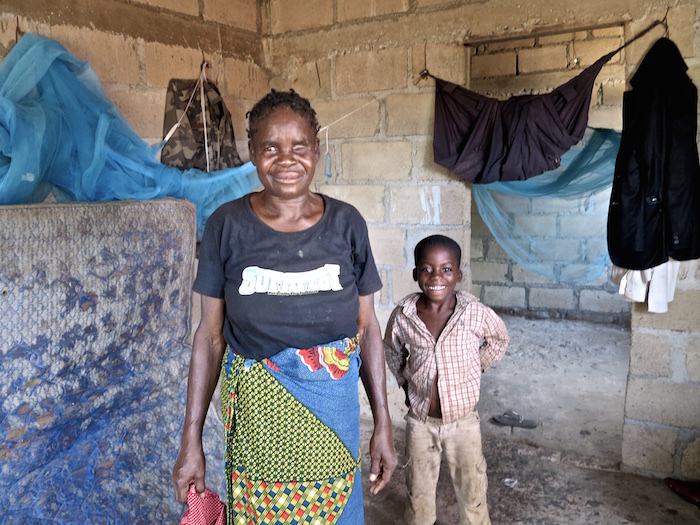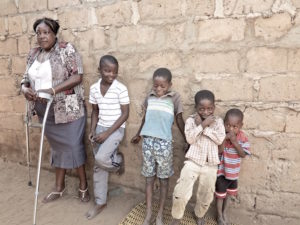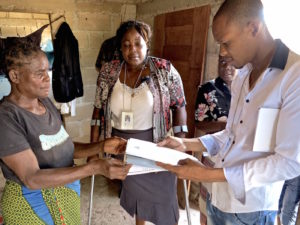Stories
‘When I dance my heart feels good’
Just north of central Maputo, sandwiched between the university and a grandly-named traffic circle called Plaza of the Heroes, is a densely packed district called Maxaquene. Before independence Maxaquene was known as one of the capital city’s caniço areas – caniço being the Portuguese word for reed – where Africans lived in precarious squatter homes made from reeds.
Only with independence in 1975 was the constant threat of demolition lifted from Maxaquene and its people started to make their homes permanent, in breeze block and corrugated iron. Sanitation and water pipes, schools, some widened roads, and other infrastructure were provided in the 1980s. But it remains a place of sandy lanes winding between the grey-brown concrete and rusting iron walls that enclose family homes and yards. Some of them will be better appointed on the inside than the walls appear, with electricity and some amenities. Few will be as desperately bare as the home of the lady we have come to visit, Lidia Jorge*.

Lidia Jorge, one of Namati Moçambique’s clients, in her house in Maxaquene, Maputo.
Lidia is a client of one of Namati Moçambique’s health advocates, Cacilda Fumo. We leave our vehicle on a widened, yet sandy road and I follow Cacilda down a narrow alley to Lidia’s modest home. The structure is two rooms of a bareness that is hard, at first, to comprehend. As a pampered visitor from the developed North, the first instinct is to think –‘Where’s all your stuff?’
The two rooms are of concrete block, with two doorways and two windows covered by cloth. There is a mattress against a wall, two mosquito nets and a low brazier of charcoal with a kettle boiling on it. Some clothing is piled in a corner. For worldly possessions that is pretty much it. Tiny children flit past the glowing coals close enough to make a nervous wreck of this parent.
Lidia is 60 years old and came to Maputo from Gaza Province, north of Maputo, when she got married at the age of 20. She has had a hard life. She gave birth to six children, but two died – one as a baby and one when aged four. Her two daughters are married and have left the house, but her two adult sons, a daughter-in-law and four grandchildren live in the house with her. One of her sons suffers from a severe learning disability. In one of the bare rooms, she sleeps with her grandchildren and disabled son, the other room for the married son and his wife. The only decoration on the wall is an election poster for the recently-elected President Nyusi.
The house may be bare, but when Cacilda first came across Lidia the family was living in the open, sleeping on the ground with no protection from the elements. Cacilda helped to find a social action group attached to a church who helped them buy materials and build this simple house. They met through a GAAC – the acronym for grupo de apoio e adesão communitário.

Namati’s health advocate Cacilda Fumo with her client Lidia’s grandchildren.
A GAAC, in the terminology of health specialists, is a ‘support and adherence group’ for people living with HIV and AIDS. GAAC members share the burden of collecting antiretroviral (ART) medicines from clinics that can be hard to reach and support one other to stay healthy. Namati Moçambique’s health advocates are strong supporters of GAACs, using them to spread the word about patients’ health rights.
Cacilda and Lidia have been members of the same 18-strong GAAC, the first to be established in Maputo, since 2010. It has regular meetings at least once a month. Lidia was diagnosed with HIV in 2006. She tells us that when she first went to the hospital with rashes and sores on her skin, a doctor said to her: ‘What will you do if we tell you that you have HIV? Will you kill yourself?’
With an adult infection rate of 11.5 percent – or around 1.5 million people – Mozambique’s HIV prevalence is among the highest in the world. In 2003, with support from PEPFAR (the US President’s Emergency Plan for AIDS Relief), the Global Fund to Fight AIDS, TB and Malaria, and a number of clinical partners, the Government of Mozambique established a free national HIV care and treatment program. Since then the country has made tremendous strides, with the number of people receiving lifesaving antiretroviral therapy (ART) having risen dramatically. While there were just 200,000 people on ART in 2010, today there are 640,000 receiving treatment. Yet despite the recent expansion and decentralization of HIV services, the country’s retention rates are still low, and it is estimated that ART coverage is just over 60 percent. The Ministry of Health has set an ambitious national target of providing treatment to 80 percent of those who clinically qualify for it by the end of 2015.
As a result of HIV-related complications, as well as high blood pressure and diabetes, doctors removed one of Lidia’s eyes. While she was ill, she says her neighbors stole a part of her plot. She points to a corner of her yard fenced off with corrugated sheet. A papaya tree pokes its leaves above the fence.
“I suffer because I give my chima (boiled cakes of maize) to the children, and the diabetes makes it hard to eat rice. Today I will have only tea.” In recent months life was made harder because Lidia’s ART regimen was changed. “It made me sick and dizzy,” she says. “There was no explanation.” Cacilda took her to the clinic and had the nurse check her records – there was no documentation of a changed regimen. Instead, Cacilda discovered that a medical technician had decided to change Lidia’s daily medicines. The technician thought he was adhering to a new national treatment plan, but he had, in fact, misunderstood it.

Lidia shows Cacilda and another Namati health advocate documents in her home in Maputo.
“The current national protocol says not to put people over 55 or those with high blood pressure and diabetes on the new drugs,” says Cacilda. “That’s why it wasn’t documented. The nurse changed her back and she is feeling better.” The technician subsequently asked Cacilda not to report the incident to the clinic’s director. Instead, Cacilda made sure the correct protocol for changing medicines was promulgated throughout the clinic.
Lidia’s already desperately hard life was being made worse by treatment that was supposed to keep her healthy. Without a health advocate taking up her case she might easily have stopped taking her antiretroviral drugs. Cacilda’s intervention with the clinic will also have had wider effects – Lidia is unlikely to be the only patient with her range of complications.
Lidia herself is a survivor. “I wasn’t afraid when they first told me I had HIV,” she says. “Even today I am not afraid. Now I am feeling better and I can dance in the church again. When I dance in the church my heart feels good, and I don’t think about anything else.”
Story by Paul McCann
*Lidia’s name has been changed.

